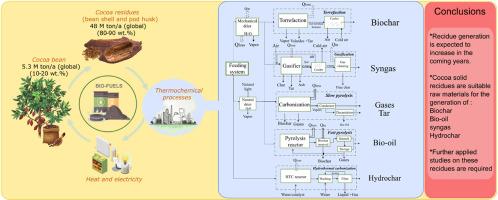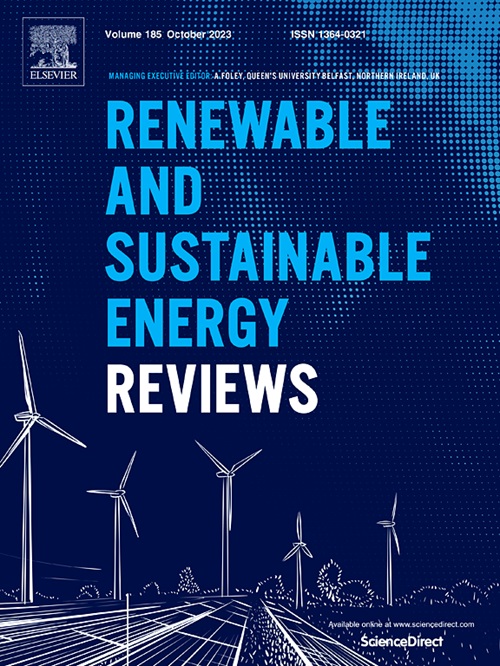可可生产链中的固体残留物:热化学价值化途径评估
IF 16.3
1区 工程技术
Q1 ENERGY & FUELS
引用次数: 0
摘要
在可可果实的生产过程中,主要产品(可可豆)只占果实总重量的一小部分,其余的 80-90% 并未用于巧克力生产。这些残余馏分很容易获得,对其在各种转化过程中作为原料的潜在用途进行评估,是对在不危及粮食安全的情况下寻找更具可持续性的生物能源的重要贡献。本研究旨在讨论可可生产链中的主要固体残留物--可可荚壳(CPH)和可可豆壳(CBS)--的特性;回顾用于改良这些残留物的转化路线;并进行质量和能量平衡,以评估它们通过直接燃烧、热解、气化、快速和慢速热解以及水热碳化等工艺在能源生产和生物燃料生产中的潜力。从所审查的工艺中收集的数据表明,从可可生产链中提取的残余生物质可被视为一种适合用于热化学转换工艺的原料,并可生成高质量的能源载体,如生物炭、水炭、生物油和合成气。本综述指出,在气化或快速热解等一些转化过程中,缺乏对这些残留物的实验研究,因此指出了进一步研究的途径。选择适当的转化技术和采用有效的废物管理策略,可以最大限度地减少这些残留物对环境的影响,同时生产出有价值的产品。这种方法可以在可可价值链中产生额外的收入流。本文章由计算机程序翻译,如有差异,请以英文原文为准。

Solid residues from cocoa production chain: Assessment of thermochemical valorization routes
In the production of cocoa fruits, the main product (cocoa beans) represents only a small part of the total fruit weight, as the remaining 80–90 % is not used in chocolate production. These residual fractions are readily available, and the evaluation of their potential use as raw materials in diverse conversion processes is an important contribution to the search for more sustainable bioenergy sources without jeopardizing food security. The present study aims to discuss the characteristics of the main solid residues of the cocoa production chain, cocoa pod husks (CPH), and cocoa bean shells (CBS); to review the conversion routes that have been applied in the improvement of these residues; and to carry out mass and energy balances to evaluate their potential in energy generation and biofuels production through processes such as direct combustion, torrefaction, gasification, fast and slow pyrolysis, and hydrothermal carbonization. The compiled data from the processes reviewed indicate that the residual biomass derived from the cocoa production chain can be considered a suitable raw material for use in thermochemical conversion processes and generate high-quality energy carriers, such as biochar, hydrochar, bio-oil, and syngas. This review identified the lack of experimental studies of these residues in some conversion processes, such as gasification or fast pyrolysis, thus indicating the pathway for further studies. The selection of appropriate conversion technologies and adoption of effective waste management strategies can minimize the environmental impact of these residues while producing valuable products. This approach could generate additional income streams within the cocoa value chain.
求助全文
通过发布文献求助,成功后即可免费获取论文全文。
去求助
来源期刊

Renewable and Sustainable Energy Reviews
工程技术-能源与燃料
CiteScore
31.20
自引率
5.70%
发文量
1055
审稿时长
62 days
期刊介绍:
The mission of Renewable and Sustainable Energy Reviews is to disseminate the most compelling and pertinent critical insights in renewable and sustainable energy, fostering collaboration among the research community, private sector, and policy and decision makers. The journal aims to exchange challenges, solutions, innovative concepts, and technologies, contributing to sustainable development, the transition to a low-carbon future, and the attainment of emissions targets outlined by the United Nations Framework Convention on Climate Change.
Renewable and Sustainable Energy Reviews publishes a diverse range of content, including review papers, original research, case studies, and analyses of new technologies, all featuring a substantial review component such as critique, comparison, or analysis. Introducing a distinctive paper type, Expert Insights, the journal presents commissioned mini-reviews authored by field leaders, addressing topics of significant interest. Case studies undergo consideration only if they showcase the work's applicability to other regions or contribute valuable insights to the broader field of renewable and sustainable energy. Notably, a bibliographic or literature review lacking critical analysis is deemed unsuitable for publication.
 求助内容:
求助内容: 应助结果提醒方式:
应助结果提醒方式:


